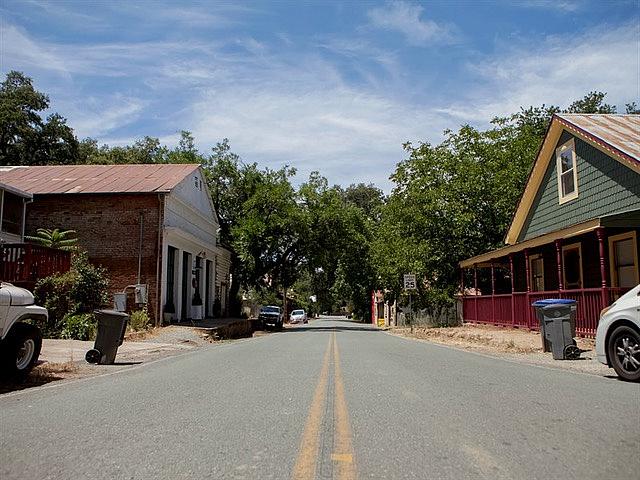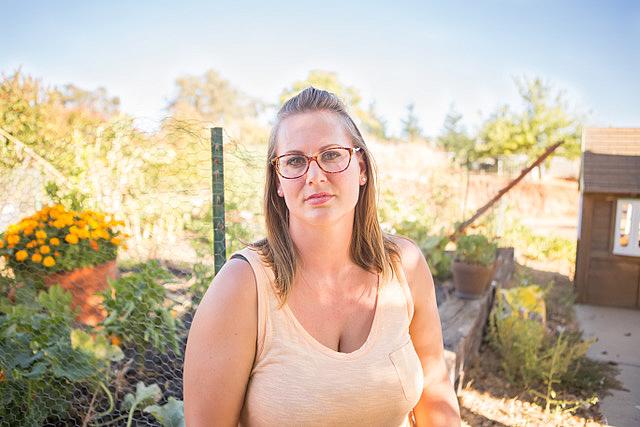How engagement helped draw one rural county’s suicide problem into the light

In Fiddletown, California, many older residents live alone and struggle to access social activities and mental health resources. Chronic loneliness is common in rural areas, and increases someone’s risk for suicide. (Photo: Capital Public Radio)
I knew I was out of my element the first time I drove to Amador County.
As I passed a lumberjack statue on the side of the highway, a giant metal cow advertising the local meat company, and a series of copper-colored signs welcoming me to each of the county’s former gold-rush towns, I wondered how I’d ever get a foothold in a place that seemed so foreign, despite being just an hour from my own doorstep.
I braced myself for resistance. From a few phone calls with local mental health activists and nonprofit leaders, I learned that most people here don’t like to talk about mental illness. Many don’t want to believe their friends and loved ones would even think about taking their own lives. That’s despite the fact that Amador County has the third highest suicide rate in the state, according to the California Department of Public Health.
The goal from the beginning was to get the information about rural suicide out to my audience by using a mix of statistics and personal stories. We wanted to get the story to the eyes and ears of those who needed to hear it the most — both people struggling silently with suicidal thoughts and their friends and loved ones who may be afraid to broach the subject.
This reporting began and ended as a joint effort with our community engagement team — jesikah maria ross of Capital Public Radio and Olivia Henry of the Center for Health Journalism. I wanted to do some field reporting at the second-ever Amador County suicide awareness walk in April. My usual plan for this would involve hanging around the 5K, approaching runners to tell them what I was working on and asking if they’d talk to me.
Instead, with help from Ross and Henry, I packed up CapRadio posters and business cards, and made a special half-sheet describing my project. I even grabbed some granola bars for the runners.
Then I set up an activity to get people to curious. I laid out brown butcher paper and a pile of post-its and markers. I asked people to write down answers to the question, “What gives you hope?”
As people came over to grab a snack and scribble an answer, I waited for them to ask me what I was up to. I met the CEO of Sutter Amador Hospital and the mother of a local 23-year-old who killed herself three years ago. Both ended up being a key part of my main web story.
And at the end of the walk, just as I was about to pack up, a woman named Ashley Moore came up to my table. We chatted about what I was working on, and she seemed amazed that I was taking an interest. She’d just recently started seeking help with her own mental illness, and seemed relieved to be able to talk about it. She gave me her phone number, and she ended up being the main character in my opening segment.
Ashley Moore, 35, said she’s done hiding her mental illness. The Camanche resident recently started seeking professional help after years of battling suicidal thoughts related to her PTSD. (Photo: Capital Public Radio)
I walked away from that morning with meaningful connections and a short list of potential interviewees. I also got a sense of what makes Amador, well, Amador. Generations of people gathered together, chatting about their pets, their kids’ athletic endeavors, their upcoming trips. Even though this group was gathered over something devastating, their community spirit prevailed.
A few weeks later, I undertook another hybrid reporting and engagement experiment. The Sierra Wind Wellness and Recovery Center in Jackson had a resource fair coming up and I decided to swing by. If nothing else, I thought I’d meet new people and learn about some mental health organizations on the ground.
I ended up sitting with county behavioral health staffer Stephanie Hess, who was open and honest about the challenges her department faces with suicide prevention. As we were speaking, a resident came up to her table and started asking about a support group for her teenage daughter, who had recently attempted suicide. It opened the door for me to meet Stacey Larson, a local mother who just recently educated herself on mental illness. She and her daughter agreed to be interviewed for my second piece on youth suicide.
Everyone I’d been talking to told me that the community gets its news from the local paper, the Amador Ledger Dispatch. So the community engagement team and I published an op-ed about my project, asking people to send an email about how suicide has impacted them. We got 17 responses. One was from Bob Hartman, a local physician and former public health officer who helped me acquire much of the data I used in the series. He was also included in my first piece as an expert on the rural physician shortage.
Another was from Terri Works who, along with her husband Andy Rodriguez, runs the Amador chapter of the National Alliance on Mental Illness. Rodriguez is also a suicide attempt survivor, and ended up sharing a powerful story for the final installment of my project.
And yet another response to the op-ed came from Scott Coleman, an Amador High School teacher who was devastated by the number of students who had attempted suicide over the years. His guidance was integral to my understanding of what it’s like to be a young person in a rural area.
Many others who responded to our call-out said they wanted to attend events around suicide prevention. So we hosted one, on June 28, for about 50 people who were already working on the issue. We decked out the Sutter Creek Community Center with floral centerpieces and scratch paper. Everyone was able to let loose and talk about a tough issue over some afternoon snacks and refreshments.
I walked away from the convening with in-person connections to important sources I’d previously only met on the phone, and a clear idea of the main themes in Amador’s suicide narrative. I allowed the community to tell me directly what they were grappling with, and what type of information would be valuable to them. It was an extremely helpful jumping-off point for my next three months of reporting, and ultimately guided the structure of the project.
Once everything was said and done, we held another community gathering to discuss the published pieces. It drew a whopping 100 people — some already grounded in prevention work, others newly awake to the problem and ready to help. As a reporter, it was a true joy to see that the project had reached so many people and increased their awareness about this important topic. We also did a follow-up piece in the local paper and a few interviews on Amador’s hometown radio station.
What we didn’t want to do was put out a project about a problem without offering any solutions or resources. So we put together a “conversation kit” of audio clips from my reporting and accompanying discussion questions, so that church groups, youth organizations or even families can host their own conversations about suicide awareness.
This was my first time working with a community engagement team, and it really changed the way I found sources and identified themes. I would highly encourage any reporter trying to break into an unfamiliar community to get creative about outreach. What you find might surprise you.

